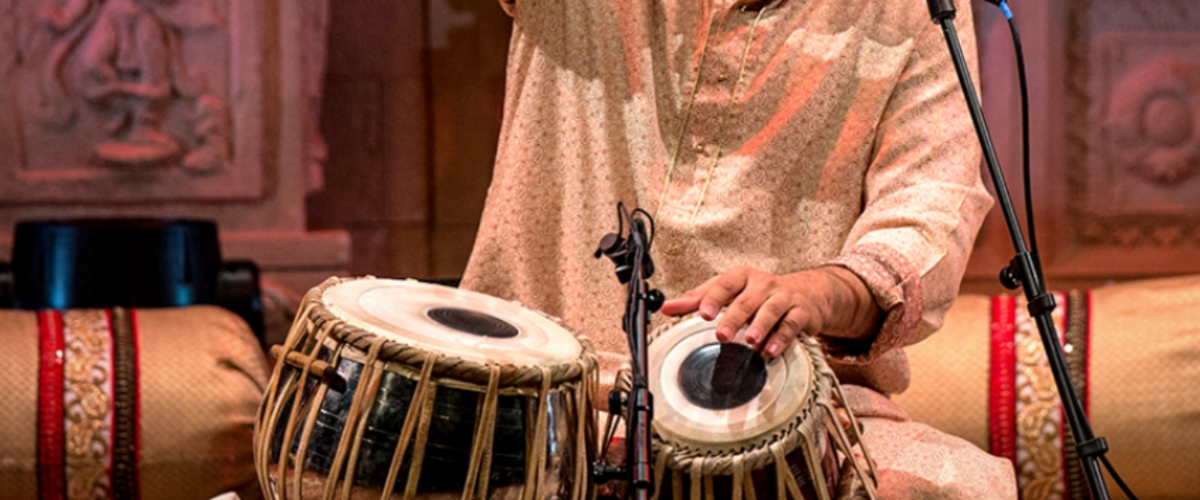

The word tabla is thought to have its origins in the Arabic word tabl, which means any kind of drum. It was undoubtedly invented in India, although its early years are shrouded in mystery and controversy.
Now North India’s most popular percussion instrument for devotional as well as classical music, the tabla consists of two drums, the smaller one of which is technically called tabla but it is more often referred to as dayan (literally ‘right’) usually played by the right, or dominant hand and a larger one played with the left hand and called bayan (literally 'left') but it is also sometimes called a duggi.
The tabla’s main distinguishing feature is that unlike older twin drums, which were always identical and played in pairs, the tabla’s two parts are both single-headed drums, of different sizes and producing entirely different timbres, with the bayan summoning a much deeper, bass tone.
The shells of both drums are covered in two layers of animal hide, the top layer helping to supress some of the unwanted overtones. There is also an old style of tabla known as jori, which was very popular for Sikh devotional as well as Afghan folk music. The left jori drum is much larger than its tabla equivalent.
Both drum heads have a central area, known as a syahi, constructed out of several thin layers of a paste made from either wheat or rice-starch to which blackening is added. It is the precise construction and shaping of this area which determines the instrument’s final tonal quality. Both drums are steadied for playing by being placed on holders made of natural fibres wrapped in cloth, slanted away from the player's body.
Playing technique involves extensive use of fingers as well as the palm to create a variety of different sounds, as well as using the heel of the hand to apply pressure in a slide-like motion to change the pitch. The dayan is always tuned to the Sa (root note) in which the instrument or vocalist is going to perform.
Because it is an instrument that consists of two drums, one popular legend claims that it was invented, specifically by the 13th century Sufi poet-musician Amir Khusrau, by cutting up either the North Indian pakhawaj or the South Indian mridangam – both ancient barrel-shaped drums – into two. Although none of Khusrau’s writings specifically mention tabla, it is still generally assumed to be North Indian in origin – and quite possibly relating to the period of Muslim influence in Indian music – because of its complete absence in the South Indian or Carnatic tradition of classical music.
The growth and development of tabla and its playing styles are closely linked to vocal styles, specifically khayal, which became very popular from the 18th century onwards as well as to centres associated with kathak dance, notably Lucknow and Benares. A tabla player’s main classification was usually a specific style linked to a particular gharana (school) of music. In the present age, many of these differences have become blurred with many world-class players drawing influence from a number of styles.
Listen to the music | Pandit Kumar Bose's style is poetic yet notoriously powerful, utilising the full range of the Benares gharana’s open-hand striking techniques. Particular awe is reserved for his control of the bayan bass drum - Bose believes that ‘it acts like water, balancing the angst with reposeful mood'. This solo, a tribute to his guru Pandit Kishan Maharaj, was recorded at Darbar Festival 2009.
Jameela Siddiqi is an author, linguist, and BBC cultural commentator, specialising in postcolonial fiction and the devotional music of South Asia.
Darbar believes in the power of Indian classical music to stir, thrill, and inspire. Explore our YouTube channel, or subscribe to the Darbar Concert Hall to watch extended festival performances, talk and documentaries in pristine HD and UHD quality.
Discover Indian classical music via styles you like - this article builds sonic bridges to rock, jazz, jungle,...
Read More 
Tabla masters combine jaw-dropping precision with hugely imaginative improvisation. Here's a primer on the world's...
Read More 
Rhythm is the arrangement of time in all music, and is thought to be older and more fundamental than melody. All...
Read More 
The beginner's guide to Indian classical music. Whether you’re completely new to raga music or just need a refresher, we’ve put together this brief overview of all things raga music to help you feel at ease when visiting one of our concerts or watch our videos on our YouTube or our Darbar Concert Hall.
Keep up to date with the latest news, events, music and musings across our social channels
For hundreds more clips and shorts, vist our YT page here 